The Samapleu-Grata-Yepleu Ni-Cu-PGE deposits, Yacouba Intrusive Complex
Western Côte d’Ivoire
Sama Resources Announces Filing of NI 43-101 Technical Report
on Samapleu-Grata Nickel-Copper Project, Côte d’Ivoire
Samapleu-Grata-Yepleu project: 2023 Technical Studies
In 2023, Ivanhoe Electric and Sama Resources through his subsidies Sama Nickel Corporation (SNC) have launched the process for a revised mineral resource at the Samapleu and Grata deposits combined with the engineering firm BBA International Inc. Additional technical studies are currently ongoing with the engineering and environmental firm Knight Piésold Consulting. It is the intention to update mineral resources in 2023 including both sectors: Samapleu and Grata.
Click here for the NI 43-101 Technical Report Mineral Resource Estimate for the Samapleu and Grata Deposits Project
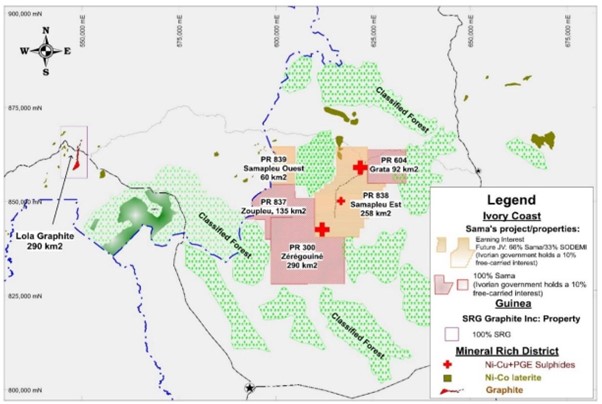
Figure 1: Sama Nickel Corporation; exploration permits in Côte d’Ivoire.
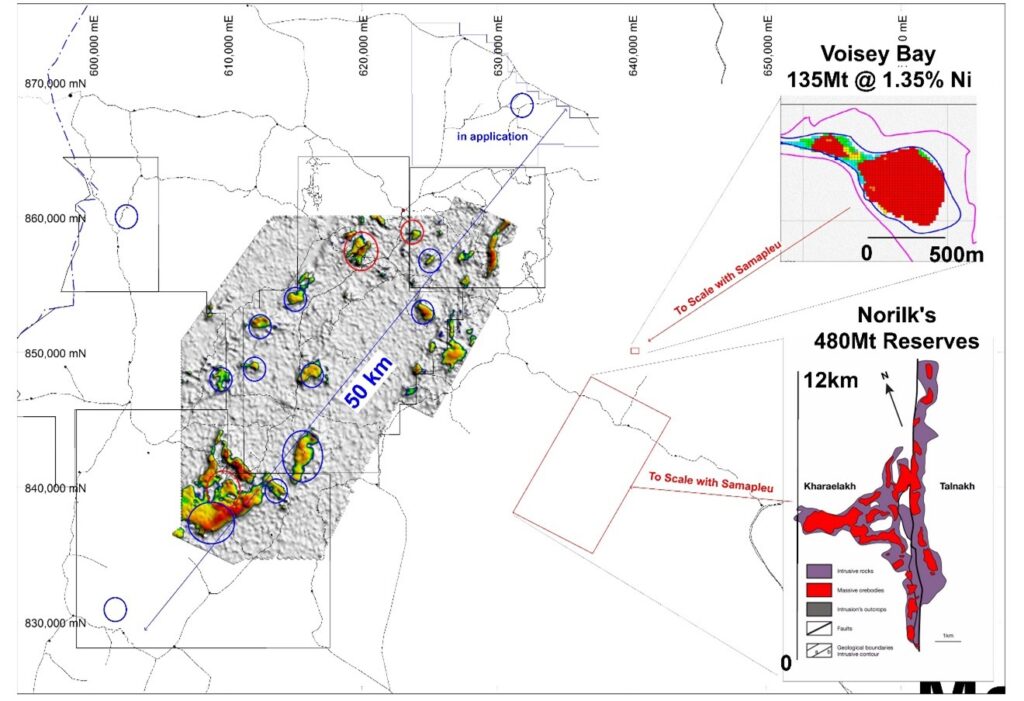
Figure 2: Samapleu, Zérégouiné, Zoupleu and Grata Exploration Permits showing 2013-18 Airborne EM targets remaining to be explored (shown by blue circles).
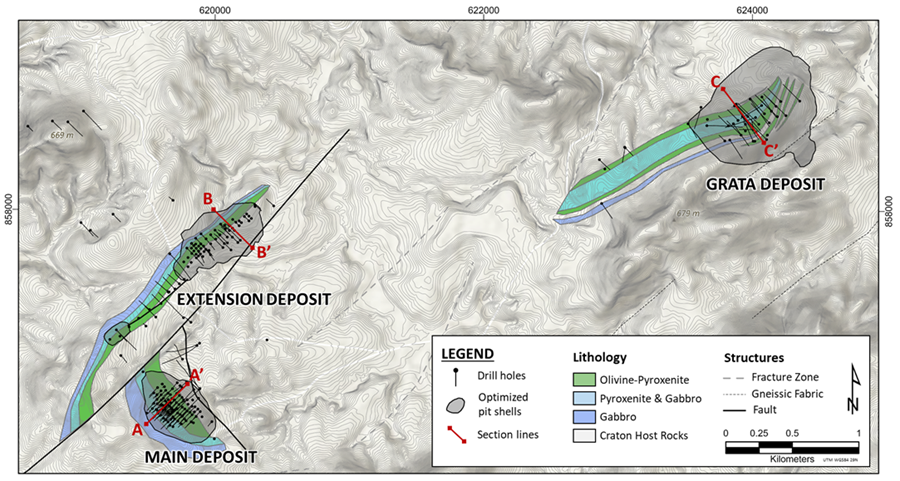
Figure 3: Newly discovered sector at Grata property located 5 km East of Samapleu. A total of 45 holes for 14,995m were drilled at Grata since the discovery in June 2021.
Samapleu Property (PR 838 & 839)
SNC entered into a Syndicate Agreement (“SA”) with SODEMI, a parastatal organization, under which SNC is responsible to finance, on behalf of the SA, exploration work programs during the exploration phase through completion of a Bankable Feasibility Study (“BFS”) on the exploration permits Samapleu East (PR 838) and Samapleu West (PR 839) held by SODEMI. SODEMI will not contribute to work conducted under the SA. Both PRs expired on June 17, 2023, with possible renewal periods totaling up to 12 years. Sama CI was required to complete an exploration program before the term of the exploration permit. This exploration program was completed on time and on March 1, 2023, Sama CI filed the required documentation with the Department of Mines in Côte d’Ivoire, for the renewal of PR 838 and PR 839 which should expire on June 17, 2026. The permits remain valid and as of today, there is no indication that the exploration permits will not be granted.
Upon completion of the BFS, the Advisory Committee (“AC”), which consists of two SNC representatives and two SODEMI representatives, will conclude on the feasibility of the project. If the AC decides to proceed with the project, an Exploitation Entity (“EE”) will be established whereby future funding will be split between SNC and SODEMI at 66.7% and 33.3%, respectively. The EE will reimburse SODEMI for all costs associated with previous exploration work conducted until January 15, 2009 up to a maximum of F CFA 834,999,457 (approximately $1,836,213 as at June 30, 2023) and will reimburse SNC for costs associated with exploration work conducted between the signature of the SA and the approval of the BFS subject to the approval of the AC which represents a total amount of $26,507,394 as at June 30, 2023. The ownership of the EE on (PR 838 and PR 829 only), shall be allocated as follows:
SNC | 60% |
SODEMI | 30% |
Government Côte d’Ivoire | 10% |
| 100% |
The Samapleu Property is subject to a 1% net smelter return royalty.
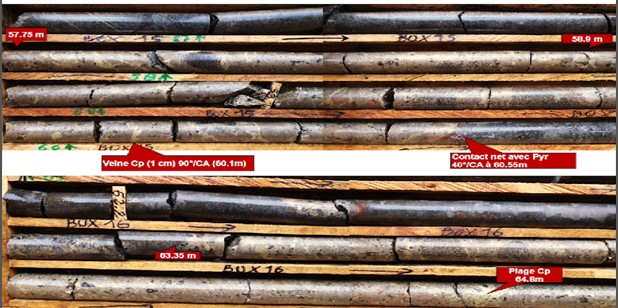
Figure 4: Hole SM44-428267 intersected 54 m of mineralized pyroxenite, grading 0.96% nickel, 0.76% copper and 0.74 gpt palladium, including a combined 8.0 m of massive sulphide grading 4.08% nickel, 2.43% copper & 2.92 gpt palladium at the Samapleu Main deposit.
Samapleu Nickel-Copper Type Mineralization
Since 2009, the Company’s regional exploration work highlights the prospective potential of the entire Sama’s prospective areas. In addition to the Samapleu Main deposit and the nickel-cobalt rich laterite Sipilou South deposit, there were several mineralized sectors that have been identified within the PR 838 (formerly old PR123) area, including the Company’s discovered Samapleu Extension 1 deposit, the Yorodougou and Bounta occurrences. as well as numerous massive chromite showings, all part of the newly discovered Yacouba Layered Complex.
The Samapleu deposits mineralization and geological characteristics are typical of a layered Pipe like intrusion or conduit‐hosted nickel deposits. These rare types of intrusions host the world’s largest nickel‐copper deposits such as: Jinchuan (515 million tons (“Mt”) at 1.06% nickel), Voisey Bay (137Mt at 1.68% nickel), Kabanga (52Mt at 2.65% nickel), Eagle (4.5Mt at 3.33% nickel), Eagle Nest (20Mt at 1.68% nickel), Kalatongke (24Mt at 0.68% nickel), and N’komati (2.8Mt at 2.08% nickel).
The Yacouba’s mafic and ultramafic hosts were intruded within the older gneissic assemblage of the West Africa’s craton. It is interesting to note that the age (2.1Ga) of the Yacouba Layered Complex is almost the same as that of the large and mineral rich South-African Bushveld complex (host of the Ivanhoe’s large Flatreef palladium-Nickel deposit and numerous other chromite+ Platinoid Group Elements deposits as well as the nearby N’Komati nickel-copper-palladium deposit).
Samapleu deposits are typical magmatic Nickel‐Copper Platinum group elements (“PGE”) deposits with common metallurgical characteristics. Nickel and copper mineralization (pentlandite, chalcopyrite, combined with pyrrhotite, rarely pyrite) correspond to sulphide disseminations ranging from trace to 40% and semi-massive to massive (40% to 100% sulphides – Figure 4) sulphide rich lenses commonly spatially associated with a strong brecciated texture in mostly pyroxenites.
In July and August 2022, the Company drilled 600 m at Samapleu Main to collect fresh mineralized material for additional metallurgical testing materials.
At Samapleu, the Company is searching for massive sulfide veins and lenses that could have accumulated in traps and embayment’s at depth along the feeder system of the large Yacouba intrusive complex.
Samapleu Extension 1 Deposit
The Samapleu Extension 1 deposit was discovered by Sama in June 2010 and is located 1.3 km north of the Samapleu Main deposit. The surface expression of the ultramafic-mafic geological host of the Samapleu Extension 1. Samapleu Extension 1 is approximately 2,000 m long by 50 m to 200 m wide and is still open in both directions. The ultramafic-mafic host is oriented northeast-southwest.
In addition to various drilling campaigns performed since 2010, the latest phase of drilling (May and August 2022) included 13 holes for 2,679 m at Samapleu Extension 1 for infill resource drilling and to collect fresh mineralized material for additional metallurgical testing materials (Figure 3).
Mineral Resource update June 2023 versus May 2020
On June 27, 2023, the Company published an updated Mineral Resource Estimate incorporating all drilling carried out at the Samapleu and Grata deposits from 2010 until mid-2022.
For the Samapleu-Grata deposits combined:
- Inferred Resources total 101.9 Mt averaging 0.25% Ni for 558.6 million pounds of Ni metal, 0.23% Cu for 526.8 Mlbs of Cu metal, 0.01% Co for 33.4 Mlbs of Co metal, 0.29 g/t Pd for 939,400 ounces of Pd and 0.1 g/t Pt for 311,400 ounces of Pt.
- The combined Indicated Resources total 14.99 Mt averaging 0.25% Ni for 81.6 Mlbs of Ni metal, 0.22% Cu for 72.9 Mlbs of Cu metal, 0.02% Co for 5.5 Mlbs of Co metal, 0.31 g/t Pd for 149,400 ounces of Pd and 0.1 g/t Pt for 49,500 ounces of Pt.
A summary of the 2023 revised Mineral Resources is provided in Tables 1 & 2. The addition of the Grata mineralization increased significantly the global mineral resources of the project compared with the 2020 PEA (Table 3). Table 2 provides a sensitivity analysis of mineral resources using various NSR cut-off values.
Table 1: 2023’s revised Mineral Resource within Pit Shells at Samapleu and Grata deposits.

Table 2: 2023’s revised In-situ Metal within Pit Shells at Samapleu and Grata deposits.

June 2023 Mineral Resource Statement Notes:
1. CIM definition standards were followed for the resource estimate.
2. The 2023 resource models used ordinary kriging (OK) grade estimation within a three-dimensional block model with
mineralized domains defined by wireframed solids.
3. Mineral resources are constrained within pit shells
a) Open pit NSR cut-off of $16.34/t milled is based on the cost/ton milled for incremental mining, processing, G&A and sustaining capital of a WMF.
4. The NSR used for reporting is based on the following:
a) Long-term metal prices of US$8.70/lb Ni, US$3.75/lb Cu, US$1,140/oz Pt, US$1,300/oz Pd, US$1,690/oz Au, US$25.10/lb Co.
b) Metallurgical recoveries are based on grade recovery curves for the various elements in a copper concentrate and nickel concentrate.
c) Bulk density was determined by a regression formula based on iron (Fe) for each lithology with each deposit.
d) Mining cost of US$4.08/t mined includes saprolite removal, incremental mining by bench and sustaining capital.
5. Mineral Resources that are not mineral reserves do not have economic viability. Numbers may not add due to rounding.
Table 3: Samapleu Project 2020’s Mineral Resources Summary (Cut-Off Grade of 0.1% NiEq) May 2020 produced by the engineering group DRA/Met-Chem.
Category | Resources (Mt) | NiEq (%) | Ni (%) |
Measured 1,2,3 | – | – | – |
Indicated 1,2,3 | 33.18 | 0.269 | 0.238 |
Meas. + Ind. | 33.18 | 0.269 | 0.238 |
Inferred 1,2,3,4 | 17.78 | 0.248 | 0.224 |
1. Mineral Resources are exclusive of Mineral Reserves
2. Capital costs of $282 million (“M’’) including contingency of $37M;
3. Operational costs of $ 2,062/t products and @22.51/t milled;
4. Pre-tax Net Present Value (“NPV”) at 8% discount rate of $615M and internal rate of return (“IRR”) of 32.5%. After-tax NPV at 8% discount rate of $391M and after-tax IRR of 27.2%
5. Average annual production of 3,900 tons (“t”) of carbonyl nickel powder, 8,400 t of carbonyl iron powder and 14,100 t of copper concentrate over a 20-year mine life;
6. Mineral Resources are not Mineral Reserves and do not have demonstrated economic viability. There is no certainty that all or any part of the Mineral Resources estimated will be converted into Mineral Reserves. The estimate of Mineral Resources may be materially affected by environmental, permitting, legal, title, taxation, socio-political, marketing, or other relevant issues.
7. The CIM definitions were followed for the classification of Indicated and Inferred Mineral Resources.
The quantity and grade of reported Inferred Resources in this estimation are uncertain in nature and there has been insufficient exploration to define these Inferred Resources as an Indicated or Measured Mineral Resource. It is reasonably expected that a portion of Inferred Mineral Resources could be upgraded with continued exploration.
Zérégouiné Property (PR 300)
SNC owns the exploration permit No. 300 (“PR 300”) which covers 290 square kilometers of property in Côte d’Ivoire and expired on December 17, 2023. In accordance with PR 300, SNC was required to complete an exploration program before the term of the exploration permit. This exploration program was completed on time and on September 20, 2021, SNC filed the required documentation with the Department of Mines in Côte d’Ivoire, for the exceptional renewal of PR 300 which should expire on December 18, 2023. As of today, there is no indication that the exploration permit will not be granted.
Yepleu Occurrence
On June 6, 2013, the Company announced the discovery of mineralized surface outcrops grading up to 1.39% nickel and 2.26% copper (tested using a hand-held Niton XRF analyzer) located 18 km southwest of the Samapleu nickel-copper deposit.
The occurrence, named Yepleu, covers an area of 24 km2 in the NE corner of the Zérégouiné Exploration Permit. Outcrops with up to 25% disseminated sulphide mineralization in mafic and ultramafic rocks and strong mineralization are seen at surface along a NW-SE strike length of 1.7 km, with some of them showing continuous mineralized horizon of up to 25 m in strike length.
The sector shows a strong HTEM conductivity covering an area of 6 km by 4 km with extension to the SW over more than 17 km (Figure 2).
The disseminated mineralization is typically characterized by fine isolated grains to large granular aggregates of nickel, copper and iron sulphides. Sulphide phases observed so far include pyrrhotite, chalcopyrite, pentlandite and minor pyrite. Pentlandite occurs as inclusions in pyrrhotite. Disseminated sulphide occurs as fine grains of 0.5 to 1 millimeter in diameter, showing a high ratio of pyrrhotite versus chalcopyrite. Sulphide veinlets and fine filaments are also present. Composite grains of sulphide material are dominant, forming sulphide masses of odd shapes ranging from a few millimeters up to several centimeters in any one dimension. The semi-massive mineralization lenses show between 30% to 70% sulphide minerals.
The Company performed a first phase of Typhoon survey in August 2018 and began the phase 2 Typhoon survey on April 1, 2019. Five holes for 4,191 m were drilled by Capital Drilling in the first half of 2019 and have intersected new mineralization at the Yepleu Sector 1 (Figure 5).
The hole YE29-556043 returned results with a combined 5.2 m of semi-massive sulfides grading 1.16% Ni, 0.62% Cu, 0.24 gpt Pd and 0.21 gpt platinum (using a cut-off-grade of 0.8% Ni) within a larger interval of 37 m of disseminated sulphide mineralization grading 0.41% Ni, 0.31% Cu, 0.23 gpt Pd and 0.17 gpt platinum. A second hole drilled at the Yepleu Sector 1 as follow-up on the mineralized zone intersected on the first deep hole (YE29-556043) returned a mineralized zone of 54 m of disseminated to semi-massive and massive sulfide material from 585 m to 639 m from the surface.
Two additional holes were drilled subsequently as follow-up on the mineralized zone intersected on the first deep hole. Hole YE29-553044 returned a mineralized zone of 54 meters of disseminated to semi-massive and massive sulfide material from 585 m to 639 m from the surface. The second hole, YE22-225440 intersected 30 meters of disseminated to semi-massive and massive sulphide, including 1.7 m of massive sulphide (> 70% sulphide).
- The Company’s discovered mineralization at 600 m at depth at the Sector 1 within the Yepleu license and within the newly discovered Yacouba Intrusive Complex (dated as the same age as the Bushveld Complex in RSA (2.1 Ga) which host the large nickel-palladium Platreef deposit) is another evidence that the Yacouba intrusion system has the potential to host a significant amount of high-grade nickel-copper-cobalt and palladium in reservoirs and pods that are yet to be discovered. Sama’s have outlined a strike length for the Yacouba Intrusive Complex of more than 66 km. The Yepleu area appears to be the center of the intrusion from where it seems to have “radiated” in all directions. This observation suggests that the Yepleu area is as proximal as we can get to the hot spot.
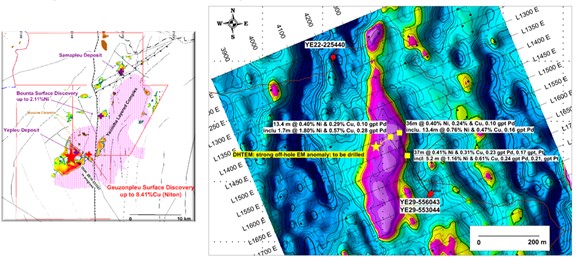
Figure 5: Sector 1 at the Yepleu property: The first deep drill hole (YE29-556043) intersected semi-massive sulfide mineralization with a combined 5.2-meter intersection grading 1.16% Ni, 0.62% Cu, 0.24 gpt Pd and 0.21 gpt Pt within a larger interval of 37 m of disseminated sulphide mineralisation grading 0.41% Ni, 0.31% Cu, 0.23 gpt Pd and 0.17 gpt Pt. Down-Hole EM survey, June 2019, return a very strong off-hole EM anomaly, 50 to 60 m SW and lower down from the YE22-225440.
Yepleu is the center of the intrusive feeder system with evidence of multiple magma injections generating a large volume of host rock assimilation (Figure 6).
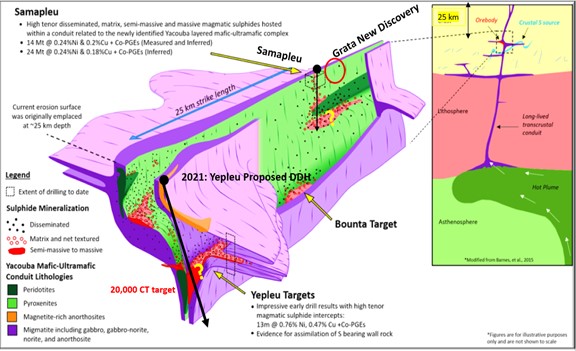
Figure 6: Schematic visualization of the Yacouba intrusive complex showing proposed targets at Samapleu, Grata and Yepleu
Grata property (PR 604)
SNC owns the exploration permit No. 604 (“PR 604”) which covers 92 square kilometers of property in Côte d’Ivoire and expired on December 7, 2025.
The property is located adjacent to the north-eastern boundary of the former Samapleu exploration permit. Sama believes that ultramafic sequences of the recently outlined large Yacouba Intrusive Complex which hosts the Samapleu Nickel-Copper-Palladium deposits, are extending within the Grata Permit and as such represent a prime target for nickel-copper-palladium mineralization.
In September 2021, Sama announced the Grata discovery located 5 km east of the Samapleu deposit. The discovery hole, GR-03, drilled in June 2021, returned a 310 m sequence of pyroxenite and gabbro containing a 147 m interval of disseminated sulfides and several intersections of semi-massive sulphide mineralization. The following are highlights: Hole GR-25 which intersected a combined 179.85 m of mineralization including 37.40 m at 0.24% Ni, 0.45% Cu and 0.54 gpt Pd and 116.95 m at 0.23% Ni, 0.23% Cu and 0.32 gpt Pd and hole GR-28 returning 194 m of combined mineralized zones including 97.85 m grading 0.30% Ni, 0.34% Cu and 0.24 gpt Pd. GR-11 drilled in January 2022 along the same section returned 212 m of combined mineralized zones including 8.20 m at 0.84% Ni, 1.10% Cu and 1.24 gpt Pd, with several narrow massive and semi-massive stringers scattered through the mineralized intervals. Holes GR-32 and GR-35 which intersected 138 m and 132 m of combined mineralized zones, respectively. Hole GR-35 included 12.40 m grading 0.39% Ni, 0.53% Cu and 0.44 gpt Pd and 78.50 m grading 0.27% Ni, 0.42% Cu and 0.25 gpt Pd. These two holes confirm the extension of mineralization toward the north-east.
Figures 7 and 8 are showing hole locations and a longitudinal cross section at the Grata occurrence.
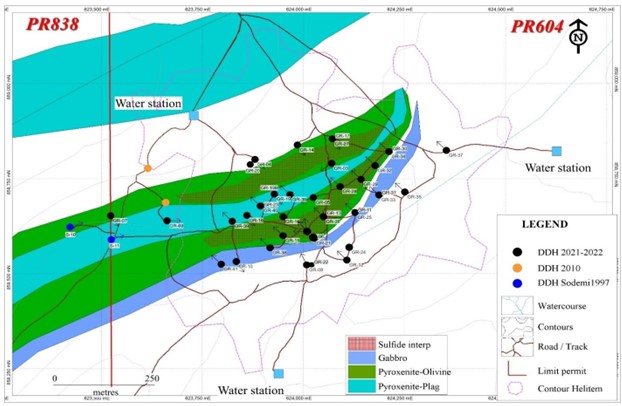
Figure 7: Grata new discovery: drill holes location and geology.
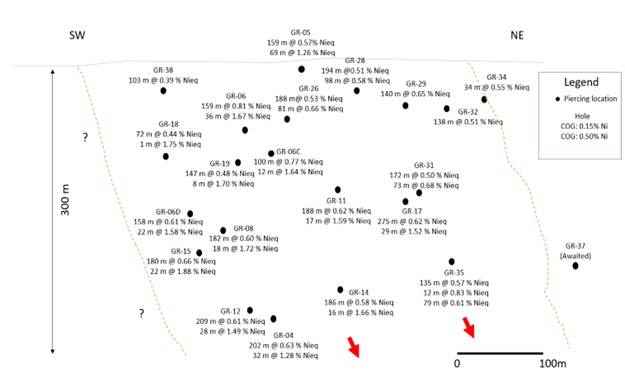
Figure 8: Grata discovery: SW-NE longitudinal cross section
- Reported widths are “combined drilled widths at cut-off grade,” not true widths.
- NickelEq%=((nickel%/100)*17,632)+((copper%/100)*8,155)+((cobalt%/100)*52,896)+((Pt ppm)/31.1)*1,200)+((Pd ppm/31.1)*1,400)))/(US$ Nickel/t*100) using the following metal prices of US$ 17,632/t nickel, US$8,155/t copper, US$1,200.00/oz Pt and US$1,400/oz Pd. Assuming 100% recovery rates of sulphides to concentrate.
The mineralization at Grata is similar in composition to the Samapleu deposit but shows a larger proportion of chalcopyrite and therefore a higher copper to nickel ratio.
The Company is looking at increasing mineral resources at Samapleu and Grata for a future surface mining operation as well as searching for massive sulphide veins and lenses that could have accumulated at depth in traps and embayment’s along the feeder system of the Yacouba Intrusive Complex.
